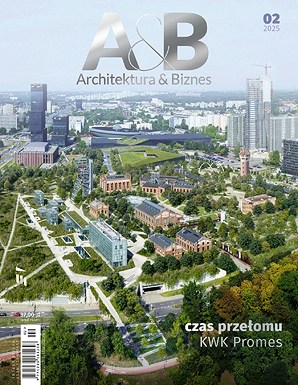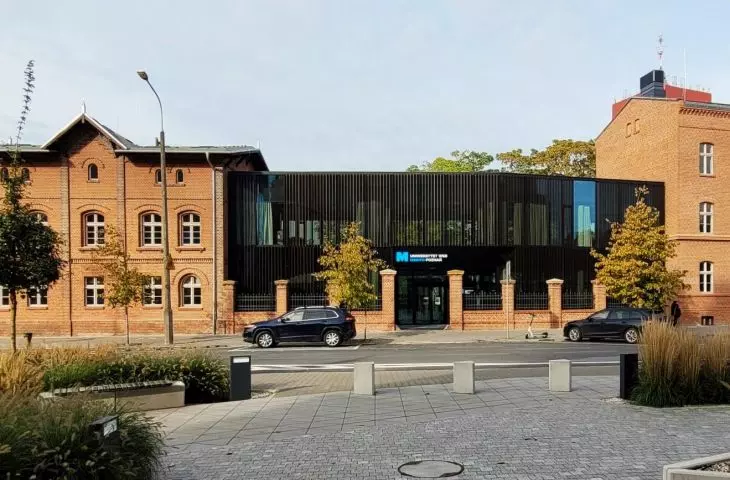Discreet and respectful of historic buildings. This is how the new part of Poznań's WSB Merito University looks after expansion. This is another centralizing development in the downtown space between Poznań Główny station and the iconic Stary Browar.
The southwestern edge of Poznań's inner city is changing at a rapid pace. At the exit of Ratajczaka Street, the office complex Nowy Rynek with a landmark building dominating the corner of the complex (designed by JEMS Architekci, completion: 2023) was built in a few years. Right next door, the city's tallest skyscraper is growing expressly: the Andersia Silver (proj. Ewa and Stanislaw Sipinski Architectural Studio, planned completion: 2025). These grandiose investments have also been joined by a more modest and discreet expansion of the private WSB Merito University (until recently: Wyższa Szkoła Bankowa) opposite the Stary Browar shopping center and the green square created in front of it three years ago. We wrote about the plans for this investment two years ago.
Expansion of the School of Banking (WSB Merito) on Ratajczaka Street in Poznań designed by Front Architects — view of Stary Browar from the drive under the new connector
photo: Jakub Głaz
sustains life
The expansion of the WSB in the center is not only spatially significant: it sustains the downtown academic life of Poznań, whose most important university — Adam Mickiewicz University — has, unfortunately, moved many of its faculties to the peripheral campus in Morasko. What will be in the new part of WSB Merito? Among other things, plans call for teaching rooms, a student zone, coworking spaces and a Social Entrepreneurship Learning Center. The accessibility of the entire complex for people with disabilities has been significantly improved with, among other things, a new elevator, stair platforms and lifts.
Expansion of the Higher School of Banking (WSB Merito) on Ratajczaka Street in Poznań, proj.: Front Architects; in the background is the late-modern skyscraper of Ekonim University.
photo: Jakub Glaz
The university's just-completed project was built on the basis of a design (multi-discipline concept) by Front Architects of Poznań. The expansion combined brick post-military buildings from the 1860s and 1870s. Three connectors united into one functional whole the larger two-story buildings used for years by the university and two smaller houses, which from the very beginning until recent years housed apartments.
brick and mantle
Thanks to the merging of the old buildings, Ratajczaka Street has gained a compact frontage at its southern end, providing a successful setting for the square in front of Stary Browar. There are no breaks in the frontage now, which does not mean that it has a uniform appearance or has completely lost its historical character. On the contrary: the architects designed lightweight glazed connectors that do not optically compete with the historic facades. The massive brick walls, which were cleaned and extensively renovated, still stand out in the foreground. The old buildings now have stylistically consistent window frames and a similar color (previously, the brick was painted clumsy with paint of various shades of red).
Expansion of the Higher School of Banking (WSB Merito) on Ratajczaka Street in Poznań proj.: Front Architects — arcade of the entrance to the new connector, preserved historic fence
photo: Jakub Głaz
The historic fence connecting the buildings so far has also been preserved and renovated. The façade of the largest two-story connector is thus located a short distance behind the wall. It has also been almost completely covered by a perforated steel screen of the original form. The architects explain the idea this way:
From the beginning of thinking about this project, glass seemed an inappropriate material and too contrasting with the 19th century brick buildings. Covering it with a „mantle” of similar texture and repetition becomes the perfect denominator between the historic and modern fabric, creating a noble, semi-transparent curtain that changes with the lighting. The aperture also brilliantly reduces excessive sunlight in the rooms and shuts out the view of the street, which is of considerable importance in study rooms that require concentration. Thanks to its spacious, openwork structure, it absorbs street noise.
Expansion of the School of Banking (WSB Merito) on Ratajczaka Street in Poznań proj.: Front Architects — openwork cover for the eastern elevation, from Ratajczaka Street
photo: Jakub Głaz
there was chaos, there are benches
The steel cover is also meant to protect birds from colliding with the glass. In addition, the openwork panels are movable to make it easier to wash the facade. Front Architects reports that they used a proprietary solution here:
the shape of the panels and the size of the meshes were individually selected by the designers. All openings were laser-cut from flat sheet metal, then stamped and bent on a custom-made profile. The difficulty was obtaining such long elements.
Extension of the School of Banking (WSB Merito) on Ratajczaka Street in Poznań proj.: Front Architects — the junction of the two-story connector and the restored brick facade, view from Ratajczaka Street
photo: Jakub Głaz
However, the new transparent connectors at the height of the second floor are without such covers: one on the street side over the entrance gate to the university complex, and the other — stretched between the largest front building and the second, even larger one, in the depth of the plot. Within the mini-campus, it was also possible to create a small green courtyard with a few rather discreetly arranged parking spaces. Haphazard pavilions have disappeared from the previously chaotic space, and there are new bike racks and benches.
Expansion of the School of Banking (WSB Merito) on Ratajczaka Street in Poznań proj.: Front Architects — greened courtyard with parking spaces, new two-story connector visible
photo: Jakub Głaz
tracks not now
Adjacent to the courtyard is the façade of the two-story connector. On this side it is entirely glass, opening up to an intimate space bounded by the neighboring kindergarten pavilion and barracks. Both of these one-story buildings should be revalued or rebuilt in the future to better complement the WSB complex on the Kosciuszko Street side. The discreet and successful metamorphosis of the post-military buildings belonging to the university may be an indication of the spirit in which to develop these neighboring downtown lots.
Extension of the School of Banking (WSB Merito) on Ratajczaka Street in Poznań proj.: Front Architects — view of Ratajczaka Street, on the right — WSB headquarters, in perspective — office building of the Nowy Rynek complex
photo: Jakub Głaz
Ratajczaka Street is also waiting for a major transformation. The city plans to build a streetcar route on it to shorten access from the Wilda district to the center. The investment has caught a delay because it ran out of money. However, the project is ready, and a short section of the new connection is being built as part of the downtown revitalization that has been underway for several years as part of the so-called Project Center. It is therefore only a matter of time before the remaining section is added, along with a pedestrian- and bicycle-friendly transformation of the busy intersection just off the New Market.




















































